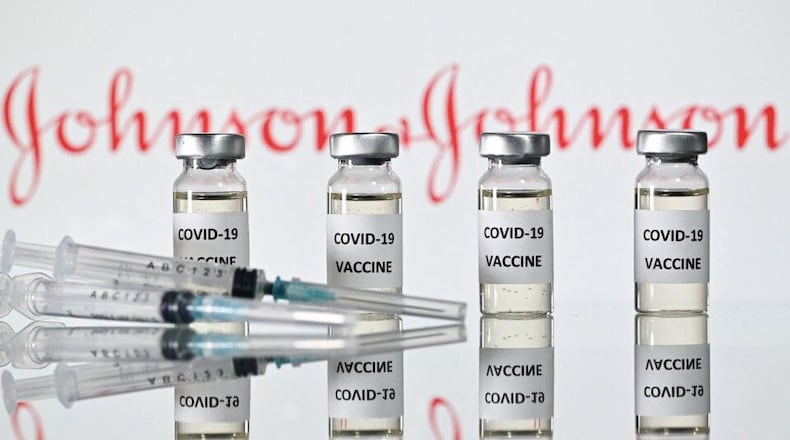Georgia pandemic workers expressed relief Friday after federal authorities decided they should still have access to the Johnson & Johnson vaccine — a key weapon as they seek to vaccinate the poor, the homebound, the skeptical and other tougher-to-reach populations.
The J&J COVID-19 vaccine was “paused” April 13 by all U.S. jurisdictions including Georgia, after federal scientists noticed a rare blood clotting syndrome that had arisen among six of the J&J recipients. Following 10 days of intensive research and seeking out more cases an advisory panel to the Centers for Disease Control and Prevention recommended on Friday that the benefits of the J&J vaccine still easily outweigh its risks.
The Food and Drug Administration and the CDC formally lifted the recommended pause Friday evening, and the Georgia Department of Public Health said it would resume offering J&J.
The panel said the J&J/Janssen vaccine should be available to all adults, though additional warning information should be added to the documentation that accompanies its federal authorization.
Public health experts had argued over whether the pause was an overreaction that would unjustly shake public confidence. That argument continued after the research during the pause turned up only a few additional cases, making for a total of 15, out of about 8 million total vaccinated with J&J.
The patients who experienced the syndrome, a combination of severe clots and severe loss of blood platelets, were all women. They fell between the ages of 18 and 59, with a cluster in the late 30s. Three died and four remain in intensive care units.
The scientists who launched the pause defended it as having educated the nation to look out for the syndrome, and alerting doctors not to use the anti-clotting drug heparin if it appears.
The panel’s support for relaunching was overwhelming. The four who voted no said they also supported relaunching the vaccine, but disagreed on whether the warning format that the panel voted for was prominent enough.
J&J is the only coronavirus vaccine authorized for use in the United States that requires just one shot, can be given without any scheduling and can be driven out and about for long periods without deep-freeze storage.
“Certainly we’re relieved that we have another available alternative” because of the flexibility the single-shot offered, said Tony Marshall, president and CEO of the Georgia Health Care Association, which represents the nursing homes industry and other long-term care providers. “It was an important part of our planning for the long term.”
Credit: Ben Gray
Credit: Ben Gray
The CDC advisory group’s options included recommending stopping the use of J&J entirely; relaunching it but restricting its use to certain populations that it suspects are at lower risk; or relaunching it broadly, perhaps with a warning attached.
While the result is just a recommendation, it will likely be followed across the nation.
As part of the research, CDC scientists programmed a computer model to predict the impact of banning or partially restricting the J&J vaccine. The model looked at the specific value of J&J to certain populations, and included what was known about people’s attitudes to vaccination at different age levels. It assumed that the Moderna and Pfizer vaccine use would continue unabated.
Banning J&J, the computer model predicted, could prevent the emergence of 26 new cases of the blood clotting syndrome, and it could also result in 1,435 additional deaths from COVID-19 of people who otherwise would not be vaccinated if they didn’t get J&J.
Vaccination efforts in Georgia and across the country have ramped up significantly in recent weeks. The United States has been administering more than 3 million shots per day for the past several weeks, according to the CDC. In Georgia, about a third of residents have had at least one dose of the vaccine, and one in five are fully vaccinated, according to DPH.
As of this week, Georgia has administered 67% of the vaccine doses it has received, according to CDC data. That’s among the lowest rates in the country.
Part of the reason is that, compared to many other states, Georgia has relatively large numbers of people in populations that have barriers to getting vaccinated, such as those without a primary care doctor or a car.
Georgia also contains relatively large numbers of African-Americans and Republican men, both populations that surveys have found to be hesitant about getting a COVID vaccine.
Those are some of the people the J&J vaccine might help.
In the U.S., the J&J vaccine has been used in fewer than 5% of vaccinations nationwide. But it plays a unique role, because it’s easy to get to people, and flexible for those who won’t or can’t set a scheduled time.
Those may be people who work multiple jobs, or people who are homebound, or the homeless. It might be those who are hesitant but will agree when they come face to face with their doctor.
In addition, the Johnson & Johnson vaccine has a more traditional vaccine recipe. That’s a fact that appeals to some who are wary of the new mRNA technology used for the Moderna and Pfizer vaccines.
Before the pause, research by the Kaiser Family Foundation found that the one-shot J&J vaccine was an appealing option for a large share of those in the “wait and see” group, with 56% of those in that category of people saying they would “probably” or “definitely” get the J&J vaccine, according to a KFF survey, indicating they were far more likely to opt for a J&J over the two-dose vaccines.
After the pause, a poll for the news service Axios found that among the somewhat hesitant, the publicity about J&J didn’t help. The poll, released, Friday, reported that 62% of those who were already going to “wait a while and see” whether to get vaccinated said that the J&J news had negatively impacted their willingness to get a vaccine.
Dr. Cecil Bennett, a Newnan-based primary care physician, had expected the vaccine to be permitted, with caution for women in the age range affected by the clotting syndrome.
“I think that’s a reasonable step to take,” Bennett said. “We know that is the population most at risk, and that’s a reasonable argument I can discuss with my patients.”
Dr. Stephen Thacker, director of pediatric infectious diseases at Savannah’s Memorial Health University Medical Center, said the committee’s decision “reflects balanced and sound review of the available information around this rare potential association with clots.”
He said health care providers should offer a discussion of the risks and benefits of the J&J vaccine and that discussion should include a conversation about the extremely uncommon but potentially dangerous blood clotting disorder. “Overall, it is clear much more harm would come from restricting access to this life-saving vaccine,” he said.
AJC Staff Writer J. Scott Trubey contributed to this article.
ABOUT THE VACCINES
Here’s a breakdown of the two other COVID-19 vaccines that have been approved by federal officials for emergency use:
Pfizer-BioNTech. The first vaccine approved for emergency use in early December, two shots are recommended for its maximum effectiveness, three weeks apart. It was found to be about 90% effective at preventing COVID-19 in clinical trials. Federal officials approved its use in people as young as 16. The primary side effects — typically after the second dose — have been fever, chills, tiredness, and headache.
Moderna. Approved for emergency use later in December, two shots are also recommended for its strongest effectiveness. The shots should be taken about four weeks apart. It was found to be about 94% effective at preventing the disease in clinical trials. Federal officials approved its use for anyone 18 and older. The vaccine has produced similar side effects, also typically after the second dose.
WHAT TO LOOK OUT FOR
The 15 women who experienced the dangerous syndrome—blood clots along with low blood platelet counts (thrombosis with thrombocytopenia)—experienced symptoms including these listed below, beginning between six and 15 days following their vaccinations.
An important difference so far between these symptoms and the normal side effects of getting the vaccine appears to be timing. Headache is an extremely common side effect of vaccination—when it begins the next day. In contrast, the patients with the clotting syndrome got their headaches for a different reason and the headaches began perhaps a week later, or in some as much as two weeks later.
· Headache
· Chills
· Fever
· Nausea/vomiting
· Malaise/lethargy
· Abdominal pain
The Latest
Featured






